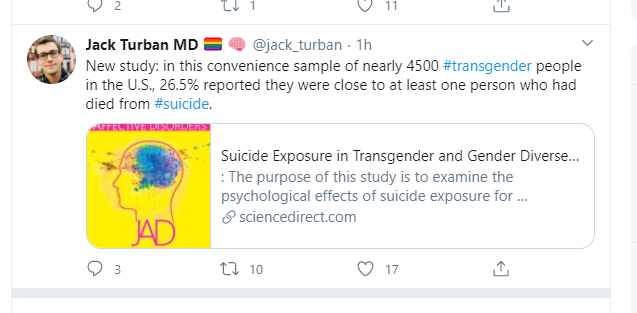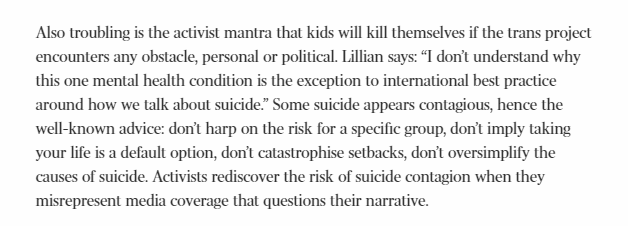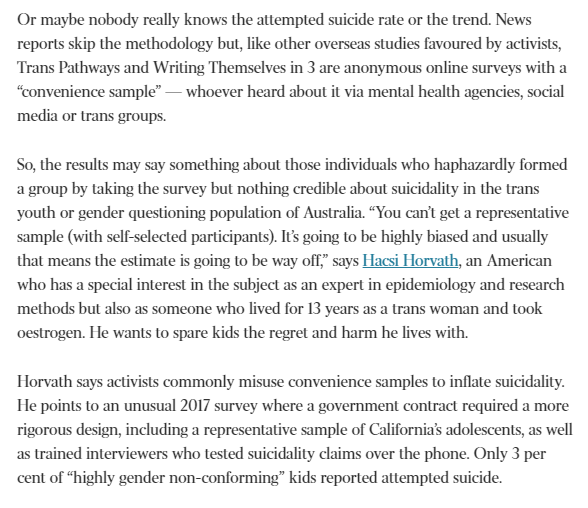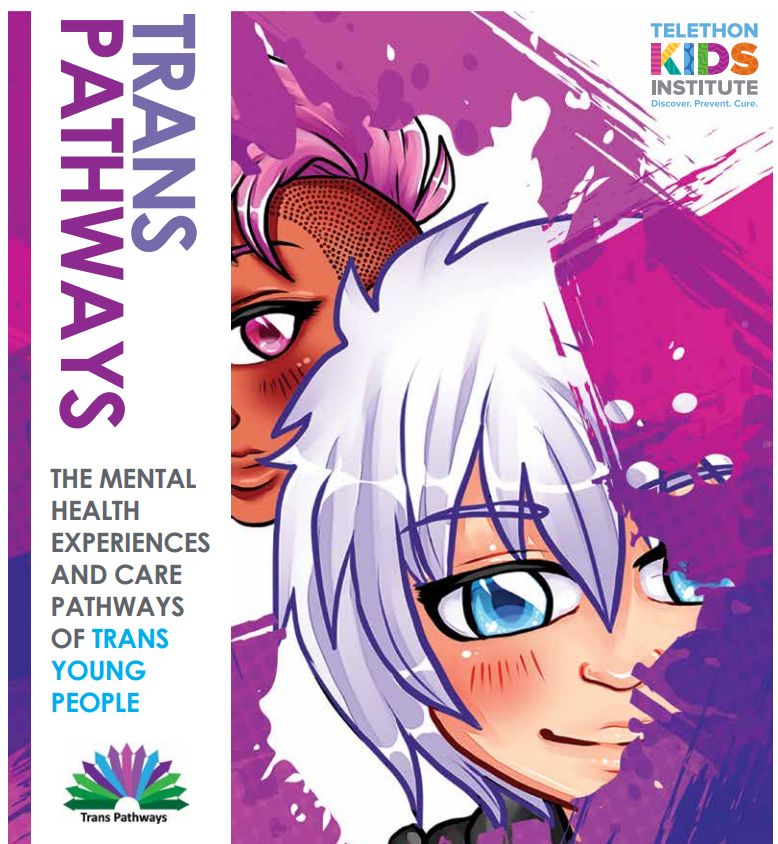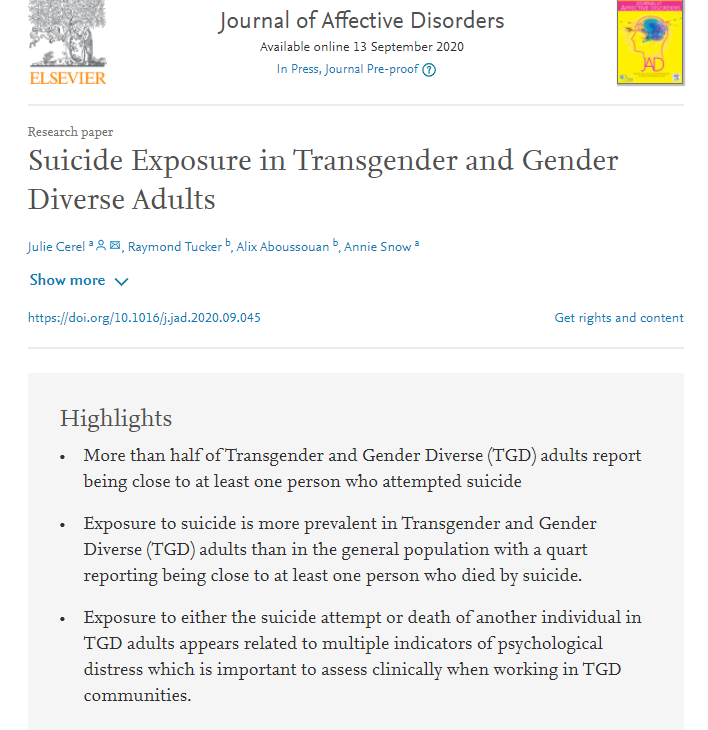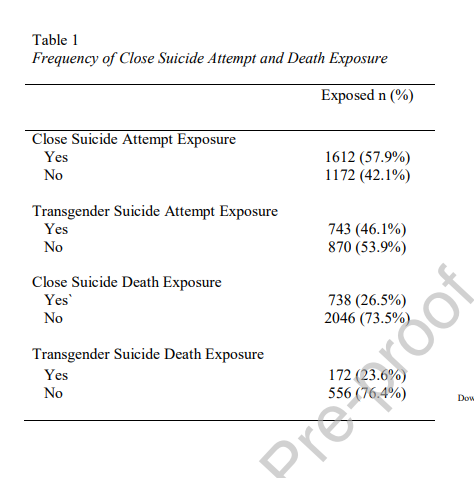No doubt Harvard& #39;s @jack_turban has reason to worry about trans people. Many teens in gender clinics present with a host of problems but is there any good data on how much suicide risk is *because* of trans issues versus, say, autism, same-sex attraction or family trauma? 1/
As for this new study, Dr Turban admits it uses a "convenience sample". Suicide risk studies relied on to promote gender clinic medicine typically claim very high risk but are low-quality from a research design point of view. I base this thread on talks with experts & reading.
These trans suicide studies can& #39;t be taken to be representative of trans people generally. They recruit participants via sources such as social media & trans activist groups, where the narrative of trans suicide risk circulates and may be reinforced by each successive study.
This cycle looks risky, because social contagion appears to play some role in suicide, and so there are mental health guides telling us how *not* to talk about suicide risk. See screenshot for comments by "Lillian", a young lesbian who used to move in trans/genderqueer circles.
The trans youth suicide studies are typically online, anonymous surveys which rely on strangers being accurate. They involve no follow-up to clarify. People can confuse self-harm with an actual suicide attempt. When trained interviewers are used, you may get less alarming rates.
The quasi-official suicide risk study for trans youth in Australia is Trans Pathways. It& #39;s another online, anonymous survey with no follow-up and a convenience sample recruited, in part, via queer university departments, peer safe spaces & trans rights & LGBTQ support groups.
As for Dr Turban& #39;s new study, it& #39;s not so new. It& #39;s based on 2017 adult data, a convenience sample, and is yet another online survey by trans advocacy groups, this time the US National LGBTQ Task Force & TransLifeline.
This non-representative group was recruited from "in-person PRIDE events as well as online listservs and other social media groups". There are trans people who prefer quiet lives, are alarmed by the recent turn in radical activism, & are less likely to end up in these surveys.
And in this study, it& #39;s not just trans. People could identify however they liked & were categorised as six groups with trans just one of them. "Two-spirit" & "pan gender" became "non-binary". "Human" became "other". All then these were headlined as "trans & gender diverse": TGD.
The online question appears to be a simple box-tick "Yes/No" with no follow-up. "Do you feel close to anyone who has attempted to end their life (but did
not die at the time)?". And "Did this person consider themselves to be transgender?".
not die at the time)?". And "Did this person consider themselves to be transgender?".
Dr Turban focuses on the more serious question: what about knowing a person who did *actually" end their life? After all, it would be surprising if exposure to such a tragedy had no effect at all on mental & emotional well-being.
Unfortunately, the survey appears to use another bald Y/N question with no follow-up or probing. And even if a given answer is accurate, the low-quality design of the survey means we have no way of knowing whether this disturbing experience is typical of trans people generally.
This screenshot gives the results. Dr Turban tweets the 26.5% figure when the close friend who died was *not* believed to be trans by the TGD person surveyed.
That& #39;s traumatic enough but an observer might think the more relevant scenario for the mental health of the TGD person is when the close friend *was* believed to be trans. This figure is 23.6%. Lower than the figure tweeted by Dr Turban, but still disturbingly high, if accurate.
But because of its weak design, this study appears to leave us none the wiser than all the previous, similar trans suicide surveys about the likely suicide risk of trans people generally, out in the real world.
And it appears there is still no good research to tell us, when a young trans person presents with an elevated suicide risk, whether that is *because* of trans/gender dysphoria issues, or other serious, non-gender issues, clinical or social or to do with family.
If the cause is not specific to trans/dysphoria, and suicide prevention is framed as a trans project, the danger is that youth with high suicide risk who *happen to be trans as well* will not get the help they need. What kind of outcome would that be for trans rights?
Imagine a study where trans people are asked to rate their emotional wellbeing *before* they were first exposed to a reporting of a trans suicide risk study. Next they would estimate how many such studies they had been exposed to since, via @Twitter & @PinkNews.
And then they would be asked to rate their present emotional wellbeing. If I were to tweet the results, I& #39;d acknowledge it was a convenience sample. (Please let me know if there& #39;s anything incorrect in this thread).
Deleted tweet re gender dysphoria. Oz study did ask, but relates risk of attempted suicide to "body dysphoria", not GD.

 Read on Twitter
Read on Twitter